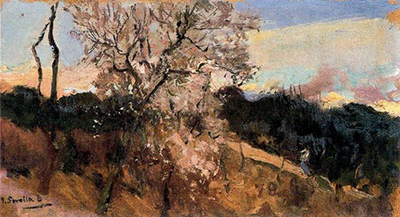 Buy Art Prints Now
Buy Art Prints Nowfrom Amazon
* As an Amazon Associate, and partner with Google Adsense and Ezoic, I earn from qualifying purchases.
Almendros de Asís, or Almond Trees in Asis, is an artwork by Joaquin Sorolla from the late 19th century. The painting is just 23cm wide, making it one of the artist's smallest pieces.
This artwork features a group of trees on the top of a hillside, which takes up most of the foreground. A path comes across on the left and on the right there is a mountain range with a considerable amount of green foliage. The top half of the canvas is then devoted to a bright sky which helps to provide a clear sectioning of the overall piece. It is a relaxed painting, no doubt produced whilst on a long summer walk and suddenly coming up with the inspiration to work. Sorolla did work en plein air on numerous occasions and in some cases he would work fairly quickly in order to concentrate on an expressive method which was fairly close to the achievements of the French Impressionists. Perhaps the most memorable element of Almond Trees in Asis are the bright pink flowers of the trees directly in front of us which will remind some of the work of Vincent van Gogh.
Nature would become a key part of the work of Van Gogh, and became particularly significant after his relocation to France where he would come across an abundance of light which was similar to what Sorolla experienced within his native Valencia. Almond Blossoms, Wheatfield with Crows and Irises are just a few of the more famous examples of his work around the themes of landscapes, trees and flowers. Sorolla himself also took great inspiration from his natural surroundings but not in quite the same way. He would make use of the beach landscapes of the shoreline in Valencia, whilst some of the other items were a random collective of architectural studies and chance encounters with particular parts of the Spanish countryside.
This painting was produced on paperboard with oils producing the forms in front of us. It can now be found in the collection of the Sorolla Museum, meaning that it is likely to have been gifted to the institution by the family at some point. This is a wonderful venue within Madrid at which one can enjoy many of his most famous paintings, plus also some deeply personal depictions of himself and his family. There is also a good amount of other documentation around his life which just helps us all to understand more about the man himself, as well as the key relationships within his life. There are not many high profile galleries devoted to a single artist in this way, but the Museo Sorolla can certainly be considered one of them, with most of the artist's work also to be found elsewhere in Madrid at the Prado Museum.



